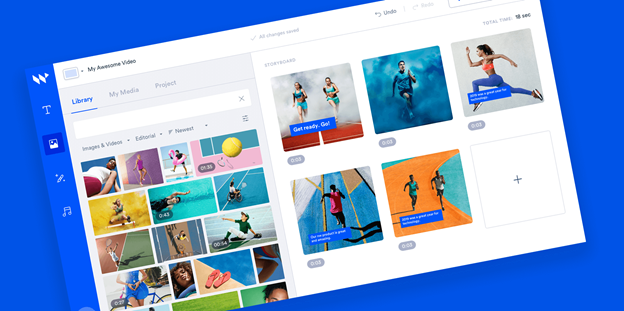Just as in any field, it’s always a good idea for digital marketers to mentor and exchange information with others in their industry.
Doing so gives you an opportunity to discuss ideas, roadblocks, and solutions with fellow business leaders that don’t work in the same office as or face the same challenges as you.
On this week’s Ignite Visibility University podcast, Ignite Visibility CEO John Lincoln explores online video makers, the future of video marketing, and much more in his one-on-one chat with Wibbitz CMO—Hilary Kay.
What We’ll Cover:
Hilary Kay’s Role at Wibbitz
Equipped with a background in branding, communications, public relations, and paid media management, Hilary Kay has been a marketing connoisseur for nearly a decade.
She first joined Wibbitz in 2015 as one of the founding team members and the company’s first Marketing Communications Manager. After 6 months, she was promoted to Director of Marketing Communications, then VP of Marketing Communications, and now serves as Chief Marketing Officer.
In her new role, Hilary Kay works closely with the Wibbitz sales team and oversees everything from the company’s global branding efforts to their communications and lead generation strategies.
She adds that “it’s been fun watching the industry evolve over the past six years and working with our customers and their video marketing strategies has also been very interesting.”

Wibbitz CMO—Hilary Kay
What is Wibbitz?
Launched in 2011, Wibbitz is an automated video creation platform that essentially analyzes text content, summarizes it, and converts it into an instant video for your site.
Creators also have access to a variety of customizable video templates, drag-and-drop editing tools, and millions of licensed photos, videos, and soundtracks to choose from so they can customize their brand story.
Since its inception, Wibbitz has partnered with numerous global brands including Bloomberg, Conde Nast, NBC Universal, Meredith, TMZ, HubSpot, S&P Global, Live Nation, and Travelink by American Express.
Key features of the software include:
- Edit or alter videos created from text.
- Licensed, first-rate photo and video content.
- Advanced algorithms can generate videos within seconds.
- Choose or paste an article URL to instantly produce videos.
- Receive a live human narration for videos in 10 minutes or less.
- Analytics that deliver insights into how well videos are performing.
Why Choose Wibbitz?
Wibbitz founders Zohar Dayan and Yotam Cohen were seeking to harness the power of video to make it easier for brands of all sizes to engage with their audiences.
They wanted it to be easy for anybody—regardless of experience or know-how— to create a high-quality professional video…fast. Unlike other video creation platforms, you don’t need to be familiar with After Effects, Premiere Pro, or other more advanced tools with Wibbitz.
You can actually create a final product that lives up to the standards that most businesses have set for their brand. Since there are so many channels marketers have to create content for, Wibbitz streamlines the process of adapting different styles and formats to fit each channel, making it much more manageable to do it at scale, and in a cost-efficient way.
How are People Utilizing Wibbitz?
Organizations are often tasked with creating promotions and campaigns for products and services in niches spanning music, sports, and food.
But how can you make a boring or complex subject more interesting to your customers? By tapping into the most popular marketing medium—video—you can cut through the noise quickly and connect with your audience right away. How?
For one, repurposing existing content into a video format is a great start. For example, you can create a sort of video version of a high-performing blog that you can embed within the blog itself. This can not only help you boost your SEO, but you can start promoting that content on social media through organic or even paid promotions to drive more traffic back to your website.
Hilary Kay also notes that she sees many Wibbitz customers using video to tell customer stories. Customer testimonial videos can definitely add an extra layer of authenticity to your marketing efforts.
Even something as simple as taking a quote from your customers and building a video having a series based around their feedback can work wonders for your brand.
Why is Video Important?
Traditional forms of marketing are no longer as effective as they were in years past.
Think about it—what captures your attention more quickly? A 2,000-word article devoid of imagery or an entertaining, professional-looking video?
With the average user spending a mere 1.3 seconds on each post in their news feed, you only have a split second to capture and hold your audience’s attention.
So if you’re wondering if it’s worth it to invest more in video marketing, a 2020 report from Wyzowl found that it is:
- 80% of video marketers say that video has directly helped boost sales.
- 89% of video marketers say that video has helped them improve their ROI.
- 83% of video marketers say that video has helped them with lead generation.
- 87% of video marketers say that video has increased incoming traffic to their website.
Even popular social media platforms like Facebook are prioritizing video in their algorithms, confirming that video outperforms text and images year after year.
Hilary Kay also points out that this pattern is reflected in the content of a Wibbitz customer who manufactures Omega-3 supplements. “They began publishing posts on social media with video for the first time and saw a 35% improvement in engagement.”
She adds that this year video engagement has been accelerated tenfold because of consumers’ radical shift in lifestyle. Since more people are staying home, they have even more time to consume content.
“A lot of people are craving the human connection that I think video just provides on another level than a tech startup or an image does,” she says.
What does the Future of Video Marketing Look Like?
By 2022, online videos are expected to make up more than 80% of all consumer internet traffic.
In today’s fast-paced, technology-driven world, video is projected to dominate both the entertainment and marketing space.
According to Hilary Kay, video is also taking over communication. Case in point: we’re already interacting with one another via live video or Zoom.
This might explain why marketers are starting to explore how they can use video to sort of fill in spaces that have been lost in a world that’s moving more toward remote work.
Even if workers do make it back into the office, Hilary Kay anticipates that digital video will continue to play a role in how we engage with our audiences.
“What we’ve seen this past year is the increase in popularity or just general affinity for more authentic content. The massive growth of TikTok is the best example of this. It’s evocative of how brands have needed to evolve as consumer preferences have changed around video.”
Ultimately, the shift towards more genuine, relatable video content is something that marketers are going to need to really embrace in order to succeed in their business.

What does the Future of Video Marketing Hold?
Wrapping Up
Hilary Kay, CMO at Wibbitz, has dubbed this era “The Golden Age of Video.”
It’s undoubtedly the most potent and persuasive medium on the market today.
That’s why Hilary Kay and the Wibbitz team have created solutions designed to empower businesses to forge meaningful relationships with their customers, drive revenue, and inspire action—all through the power of video.
